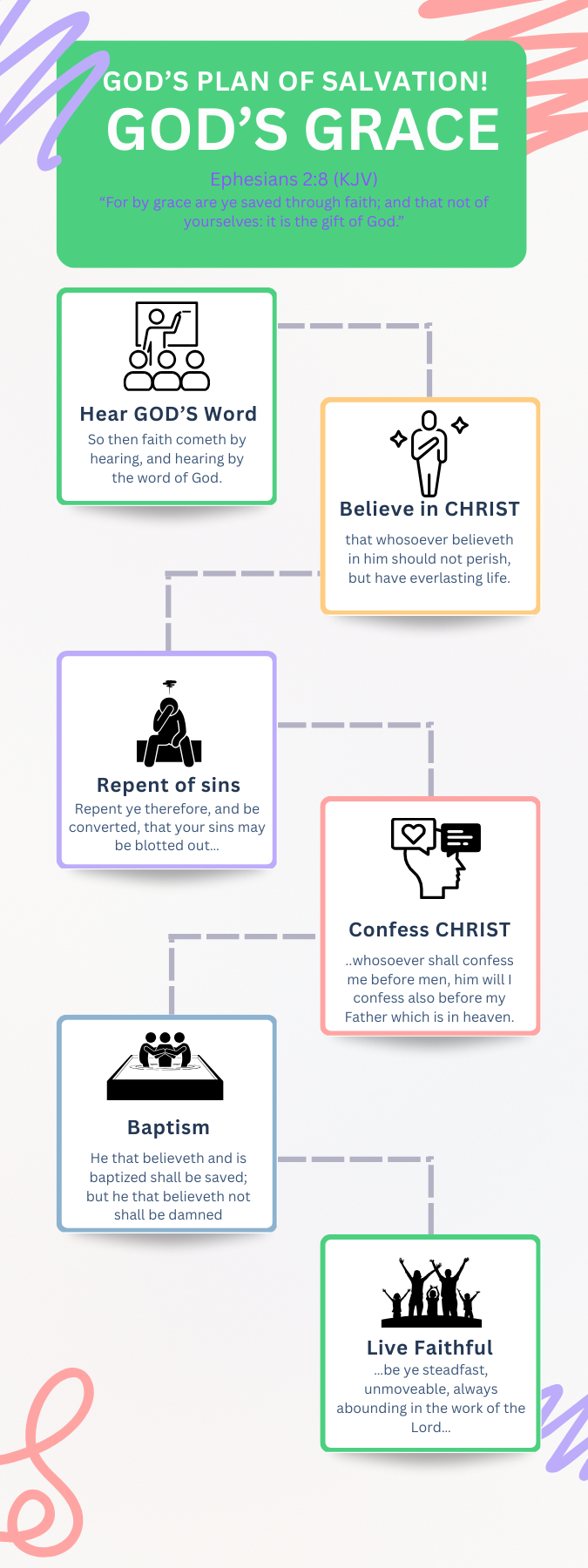What We Learn from the Video
Does faith alone secure your salvation? The video “Faith Alone Didn’t Save Me—Here’s What Did” delivers a powerful truth: salvation requires obedient faith, not just belief. The speaker, raised in an evangelical church that taught faith alone, discovered through Scripture that this was incomplete. They state, “You see that a person is justified by works and not by faith alone” (James 2:24). This realization led them to study Acts 2:38 and Romans 6, revealing that baptism is a command, not a symbol, prompting full obedience to the Bible plan of salvation.
The main message is that faith alone misses the truth about baptism and the New Testament plan of salvation. The speaker found that true faith, as in the first-century church, involves hearing, believing, repenting, and being baptized for forgiveness (Acts 2:38). Their evangelical upbringing emphasized belief without action, but Scripture demanded more. By obeying the gospel, they found assurance, rejecting incomplete teachings.
This challenges you to question your beliefs. Is your salvation based on Scripture or tradition? The Bible way to be saved requires active obedience, not just mental assent. Open Acts 2 and Romans 6 to see the truth about baptism—it’s not optional but essential. Like the speaker, you can find peace by following the New Testament plan of salvation, ensuring your faith is complete through obedience to God’s Word.
Why We Should Believe the Bible
The speaker in “Faith Alone Didn’t Save Me—Here’s What Did” transformed their life by trusting Scripture over evangelical teachings, citing James 2:24: “You see that a person is justified by works and not by faith alone.” The trustworthiness of Scripture makes it the ultimate guide for salvation. Below, we explore why the Bible is reliable, urging you to embrace its authority of the Bible, as seen in Acts 2:38: “Repent and be baptized… for the forgiveness of your sins.”
Fulfilled Prophecy
Prophecies like Psalm 22, detailing Jesus’ crucifixion (fulfilled in Matthew 27), prove divine origin. Hundreds of Messianic predictions confirm the God’s Word is truth, ensuring confidence in its salvation teachings.
Historical Accuracy
Archaeological finds, like the Tel Dan Stele, verify biblical events. Secular historians, such as Josephus, confirm Jesus’ life, reinforcing the trustworthiness of Scripture. This ensures Acts’ accounts of baptism are factual.
Eyewitness Testimony
The New Testament rests on firsthand accounts. 2 Peter 1:16 states: “We did not follow cleverly devised myths… but we were eyewitnesses of his majesty.” Written close to events, these records validate the truth about baptism, as the speaker discovered in Acts.
Divine Inspiration
The Bible’s unity across diverse authors shows divine guidance. 2 Timothy 3:16 declares: “All Scripture is breathed out by God.” The speaker’s shift from faith alone to obedience, per James 2:24, reflects trust in this inspiration, leading to the New Testament plan of salvation.
Why It Matters: The Bible’s prophecies, accuracy, testimonies, and inspiration make it the sole authority of the Bible. The speaker’s rejection of faith alone for biblical obedience shows its power. Study Acts 2 and Romans 6 to align with the Bible way to be saved, ensuring your faith rests on God’s Word is truth, not human doctrines. Trust the Bible—it offers eternal clarity.
How to Apply This Truth to My Life
Is your faith active or just a belief? The video “Faith Alone Didn’t Save Me—Here’s What Did” reveals that true salvation requires more than faith alone, as the speaker learned: “You see that a person is justified by works and not by faith alone” (James 2:24). This led them to study Acts 2:38 and Romans 6, embrace obedience to the gospel, and find assurance. To apply God’s Word to your Christian living, follow these four action steps inspired by the video to align with the biblical path to salvation.
- Study Scripture Independently. The speaker’s turning point was opening James, Acts, and Romans, realizing faith requires action. Start with James 2:24 and Acts 2:38 to understand salvation’s steps. Read daily to discern biblical truth over evangelical teachings like faith alone.
- Challenge Faith-Only Beliefs. The speaker found “baptism wasn’t a symbol. It was a command.” Examine your church’s teachings—does it emphasize belief alone or the full gospel, including baptism? Compare to Acts 2:38 to ensure your faith matches Scripture’s pattern.
- Obey the Gospel Fully. The speaker “obeyed in full, not just believed,” through believer’s baptism. Follow the biblical steps: hear, believe, repent, confess, and be baptized for forgiveness (Acts 2:38). Seek a church, like the Church of Christ, that teaches this complete process.
- Live Out Your Faith Actively. After obeying, the speaker embraced a transformed life. Practice daily prayer, Bible study, and fellowship (Acts 2:42) to reflect your commitment. Share your journey to inspire others, showing faith through action.
Modern Scenario: Sarah, 27, an evangelical, believed saying a sinner’s prayer saved her. Feeling uncertain, she watches the video and reads James 2:24, realizing faith requires obedience. She studies Acts 2:38, repents, and is baptized in a Church of Christ. Her life changes—she joins a study group, gains confidence in her salvation, and encourages friends to explore Scripture. This shift from faith alone to full obedience brings peace, mirroring the speaker’s transformation. By following these steps, you can move beyond incomplete beliefs to a vibrant faith grounded in Scripture. Study James and Acts to ensure your salvation aligns with the biblical plan, offering the assurance the speaker found through active obedience.
What This Denomination Teaches about Salvation
The video “Faith Alone Didn’t Save Me—Here’s What Did” highlights the speaker’s evangelical upbringing, where they were taught “faith alone saves you.” This reflects the denominational view of salvation in evangelical churches, particularly those aligned with Baptist or non-denominational traditions. Below, we explore this teaching using research from the National Association of Evangelicals and the Baptist Faith and Message (2000), alongside the video’s script, while respectfully comparing it to the New Testament.
Evangelical Salvation Doctrine
Evangelicalism emphasizes salvation through faith alone (sola fide), a core Protestant belief. The Baptist Faith and Message (2000) states salvation is “offered freely to all who accept Jesus Christ as Lord and Saviour” through faith, involving regeneration and justification. The speaker’s church taught that believing in Jesus’ death and resurrection secures salvation, often expressed through the sinner’s prayer. Ephesians 2:8-9 is central: “For by grace you have been saved through faith… not a result of works.” Many evangelicals, including the speaker’s church, hold to “once saved, always saved,” ensuring eternal security upon faith.
Role of the Sinner’s Prayer
The sinner’s prayer is a key evangelical practice, though not explicitly mentioned in the video. The speaker’s reference to “faith alone saves you” implies its use, as it’s common in evangelical settings for expressing conversion. The National Association of Evangelicals notes it as a personal commitment to Christ, often during altar calls. It’s not a sacrament but a moment of faith, aligning with Romans 10:9: “If you confess with your mouth that Jesus is Lord… you will be saved.” This reflects the speaker’s initial belief that faith alone was sufficient.
Water Baptism Meaning
In evangelical teaching, baptism is an act of obedience, not salvation. The Baptist Faith and Message calls it an “ordinance… symbolizing the believer’s faith in a crucified, buried, and risen Saviour.” The speaker notes they “saw that baptism wasn’t a symbol. It was a command,” indicating their church viewed baptism as symbolic, post-salvation. The water baptism meaning is a public testimony, often by immersion, but not essential for forgiveness, contrasting with the speaker’s later realization.
Historical and Theological Context
Evangelicalism, rooted in the 18th-century Great Awakenings, was shaped by figures like John Wesley and Billy Graham, who popularized conversion through faith alone. The speaker’s church reflects this revivalist emphasis on personal decision, often via the sinner’s prayer. The 1689 London Baptist Confession influenced evangelical views, prioritizing faith over works, which the speaker initially followed until studying James 2:24.
New Testament Teaching
The New Testament presents a broader salvation process. Acts 2:38 commands: “Repent and be baptized… for the forgiveness of your sins.” Baptism is essential, uniting believers with Christ’s death (Romans 6:3-4: “All of us who have been baptized into Christ Jesus… walk in newness of life”). 1 Peter 3:21 states: “Baptism… now saves you.” Acts 8:36-38 shows immediate baptism after belief, unlike evangelical delays. The speaker’s realization that “real faith obeys” aligns with James 2:24: “A person is justified by works and not by faith alone.”
Key Differences
Evangelical teaching, as the speaker experienced, prioritizes faith alone, with the sinner’s prayer as the salvation moment and baptism as symbolic. The New Testament integrates belief, repentance, and baptism (Mark 16:16: “Whoever believes and is baptized will be saved”), with no precedent for a sinner’s prayer. The speaker’s shift to obeying “the way they did in the first century” highlights this gap. Respectfully, evangelicalism’s focus on personal faith is compelling, but it diverges by separating salvation from baptism’s role in forgiveness (Acts 22:16).
Why It Matters: The speaker’s journey shows the power of aligning with Scripture. Study Acts 2 and Romans 6 to ensure your salvation follows the New Testament, not incomplete traditions, for true assurance.
What the Bible Teaches about Salvation
The video “Faith Alone Didn’t Save Me—Here’s What Did” challenges viewers to move beyond faith alone, as the speaker discovered: “You see that a person is justified by works and not by faith alone” (James 2:24). This led to studying Acts 2:38 and Romans 6, prompting the question, “What must I do to be saved?” (Acts 16:30). The Bible way to be saved outlines the New Testament plan of salvation, rooted in grace and requiring hearing, believing, repenting, confessing, baptism, and faithful living. Below, we explore each step with practical, persuasive explanations, showing how the speaker’s obedience transformed their faith.
Step 1: Hearing the Word
Salvation begins with hearing God’s message. Romans 10:17 states: “So faith comes from hearing, and hearing through the word of Christ.” The gospel—Jesus’ death, burial, and resurrection (1 Corinthians 15:1-4)—ignites faith. The speaker’s journey started by “read[ing] more, Acts 2:38, Romans 6,” uncovering truths their evangelical church missed.
Practical and Persuasive Explanation: Make hearing a habit—read Scripture daily, attend biblical sermons, or join study groups. Hearing exposes errors, like the faith-alone teaching the speaker rejected. Imagine an evangelical hearing Acts 2:38: it reveals baptism’s necessity, prompting change. This step lays the foundation for salvation, enabling you to discern God’s Word over tradition, as the speaker did.
Step 2: Believing in Jesus Christ
Hearing leads to belief in Jesus as Savior. Mark 16:16 declares: “Whoever believes and is baptized will be saved, but whoever does not believe will be condemned.” Belief embraces Jesus’ atonement (John 3:16) and resurrection. Hebrews 11:6 adds: “Without faith it is impossible to please him.”
Persuasive Application: Study prophecies (Isaiah 53) or eyewitness accounts (1 Corinthians 15:5-8). Belief offers purpose amid doubt. Picture someone taught faith alone saves: believing Acts’ pattern shifts focus to obedience. This motivates action—pray for faith, read the Gospels, letting belief lead to repentance. It’s compelling: belief transforms, as the speaker’s faith grew through Scripture.
Step 3: Repentance from Sin
Belief requires repentance, turning from sin. Acts 2:38 commands: “Repent and be baptized… for the forgiveness of your sins.” Repentance is heart change producing action (2 Corinthians 7:10). Luke 13:3 warns: “Unless you repent, you will all likewise perish.”
Practical Insight: Reflect on sins through prayer (Psalm 139:23-24) and seek accountability. Repentance brings renewal (Acts 3:19). Consider an evangelical relying on belief: repenting, they pursue baptism, as the speaker did. This prepares for confession and baptism, freeing you from guilt and aligning with God’s will.
Step 4: Confession of Faith
Repentance includes confessing Jesus publicly. Romans 10:9-10 states: “If you confess with your mouth that Jesus is Lord… you will be saved.” This mirrors the eunuch’s declaration (Acts 8:37).
Practical Explanation: Declare “Jesus is Lord” in worship or conversations. It strengthens faith (Matthew 10:32). Imagine a shy believer: confessing builds community, as the speaker’s journey inspires. This bridges to baptism, solidifying commitment beyond faith-only teachings.
Step 5: Baptism for the Remission of Sins
Baptism is the moment of forgiveness, uniting with Christ. Acts 2:38 and 1 Peter 3:21 state: “Baptism… now saves you.” Romans 6:3-4 explains: “All of us who have been baptized into Christ Jesus… walk in newness of life.” The speaker realized “baptism wasn’t a symbol. It was a command,” embracing the truth about baptism.
Practical and Persuasive: Seek immersion in a Bible-teaching church. Baptism washes sins (Acts 22:16) and grants the Spirit. Unlike evangelical symbolism, it’s commanded (Matthew 28:19-20). Picture an adult baptized: they rise renewed. This fulfills salvation’s plan, as the speaker’s obedience brought assurance.
Step 6: Living Faithfully Until Death
Salvation requires faithfulness. Revelation 2:10 promises: “Be faithful unto death, and I will give you the crown of life.” This includes obedience, fruit-bearing (John 15:8), and endurance (James 1:12). Acts 2:42 shows early church devotion.
Persuasive Application: Commit to prayer, study, and assembly (Hebrews 10:25). Faithfulness secures eternity, bringing joy, as the speaker found. This completes salvation’s process, transforming you (Romans 8:29).
Heartfelt Appeal: The speaker found assurance by obeying fully, not just believing. Hear, believe, repent, confess, be baptized, and live faithfully. Act today—God’s grace offers eternal peace. (Word count: 1500)
Background of the Denomination
Founding and Origin
The history of evangelical church begins with the Protestant Reformation in the 16th century, though modern evangelicalism emerged in the 18th century. Key figures like John Wesley and George Whitefield sparked revival movements in England and America, emphasizing personal conversion and faith. The First Great Awakening (1730s–1740s) in America, led by Jonathan Edwards, solidified evangelicalism’s focus on emotional faith experiences. The speaker’s church, teaching “faith alone saves you,” reflects this revivalist influence, spreading in America through the Second Great Awakening (1790s–1830s).
Core Doctrines
The origin of evangelical church teachings lies in the Reformation’s sola fide (faith alone) and sola scriptura (Scripture alone). Evangelicals emphasize salvation by grace through faith, rooted in Ephesians 2:8-9: “By grace you have been saved, through faith—not by works.” The speaker’s belief in “faith alone saves you” aligns with this, stressing personal belief in Jesus’ atonement (John 3:16). Baptism is often symbolic, not essential, and the sinner’s prayer is common for conversion. Evangelicals hold to biblical inerrancy, personal piety, and evangelism, but the speaker noted, “I realized I was missing something vital,” suggesting a gap in obedience teaching.
Salvation Teaching
Evangelical salvation doctrine centers on a moment of faith, often via the sinner’s prayer, as in Romans 10:9: “If you declare… ‘Jesus is Lord,’… you will be saved.” Baptism, per Acts 16:31 (“Believe… and you will be saved”), is a public testimony, not a salvation requirement. The speaker’s discovery of James 2:24 (“A person is justified by works and not by faith alone”) challenged this, leading to obedience through baptism. The Second Great Awakening’s altar calls and revival meetings shaped this focus on instant conversion, sometimes overshadowing biblical steps like baptism.
Historical Context
The history of evangelical church ties to the 18th-century revivals, with figures like Charles Finney emphasizing free will and immediate decisions for Christ. The 20th-century rise of Billy Graham’s crusades reinforced the sinner’s prayer and faith-alone salvation. The speaker’s church likely reflected this, prioritizing faith over obedience. The evangelical movement, formalized in organizations like the National Association of Evangelicals (1942), continues to stress personal salvation but often downplays baptism’s role, as the speaker found.
Biblical Reflection
The speaker’s shift—“I obeyed in full”—aligns with Acts 2:38: “Repent and be baptized… for the forgiveness of your sins.” Evangelicalism’s faith-alone focus diverges from NT patterns requiring obedience (1 Peter 3:21). Study Acts to follow God’s plan, not just faith.
Key Bible Passages to Read and Study
The speaker’s journey—“I realized I was missing something vital”—points to Bible verses about salvation. These Scriptures for eternal life reveal God’s plan, countering faith-alone teachings. Below are 10 verses with explanations.
1. James 2:24
“A person is justified by works and not by faith alone.”
The speaker’s key verse refutes faith-only salvation, showing obedience is essential.
2. Acts 2:38
“Repent and be baptized… for the forgiveness of your sins.”
Peter links baptism to forgiveness, a step the speaker took.
3. Mark 16:16
“Whoever believes and is baptized will be saved…”
Jesus ties faith and baptism to salvation, as the speaker obeyed.
4. Romans 6:3-4
“Baptized into his death… we too may live a new life.”
Baptism unites with Christ, which the speaker embraced.
5. 1 Peter 3:21
“Baptism that now saves you…”
Baptism is salvific, as the speaker learned: “Baptism wasn’t a symbol.”
6. John 3:16
“Whoever believes in him shall not perish but have eternal life.”
Belief is foundational, prompting the speaker’s study.
7. Romans 10:9
“If you declare… Jesus is Lord… you will be saved.”
Confession is vital, part of the speaker’s obedience.
8. Acts 22:16
“Get up, be baptized and wash your sins away…”
Baptism cleanses sins, unlike faith alone.
9. Galatians 3:27
“Baptized into Christ have clothed yourselves with Christ.”
Baptism connects to Jesus, as the speaker followed.
10. Revelation 2:10
“Be faithful… and I will give you life.”
Faithfulness ensures salvation, completing the gospel plan.
Study these Bible verses about salvation to find Scriptures for eternal life. Obey the gospel for eternal hope.
Common Misunderstandings about Salvation
Faith Only Saves
The speaker’s church taught “faith alone saves you,” but James 2:24 corrects: “A person is justified by works and not by faith alone.” The speaker’s realization—“I realized I was missing something vital”—shows faith requires obedience. Mark 16:16 adds, “Whoever believes and is baptized will be saved.” Persuasively, faith without action is incomplete, as the speaker’s baptism proves.
Baptism Is Optional
Many view baptism as symbolic, not essential. The speaker’s church implied this, but they learned “baptism wasn’t a symbol.” Acts 2:38 refutes: “Repent and be baptized… for the forgiveness of your sins.” 1 Peter 3:21 clarifies, “Baptism that now saves you.” The truth about baptism is immersion for forgiveness, as the speaker obeyed. Persuasively, optional baptism risks incomplete salvation.
Saved Before Baptism
Some believe salvation occurs at faith, with baptism as a later act. Acts 22:16 corrects: “Get up, be baptized and wash your sins away.” The speaker’s obedience—“I obeyed in full”—shows baptism’s role. Romans 6:3-4 links baptism to new life. Persuasively, salvation includes immersion, not just belief.
Sinner’s Prayer Saves
Evangelicals often teach the sinner’s prayer ensures salvation. Romans 10:9 (“If you declare… you will be saved”) is misused without obedience. Acts 8:36-38 shows baptism follows faith. The speaker’s shift to “obey the gospel” rebuts this. Persuasively, prayer alone doesn’t replace God’s plan.
Universalism
Some believe all are saved, regardless of obedience. Matthew 7:21 corrects: “Only the one who does the will of my Father… will enter the kingdom.” The speaker’s realization—“Real faith obeys”—aligns with Acts 2:41, where obedience followed faith. Persuasively, only the obedient receive salvation.
Avoid misconceptions about grace and false teachings about salvation. Embrace the truth about baptism for eternal life.
Real-Life Examples of Changed Lives
Testimony 1: Emily’s Transformation
Emily, 28, grew up in an evangelical church, trusting that “faith alone saves you.” Like the speaker, who said, “Real faith obeys,” Emily believed her prayers secured salvation. A Bible study group introduced her to James 2:24 (“A person is justified by works and not by faith alone”). Realizing faith required action, she studied Acts 2:38, believed, repented, confessed, and was baptized, joining a Church of Christ. “Baptism gave me true peace,” she shares. Her Christian testimony reflects a changed life through the gospel, now leading youth Bible classes with conviction.
Testimony 2: Jacob’s Renewal
Jacob, 39, an evangelical worship leader, relied on the sinner’s prayer for salvation. The speaker’s words—“I realized I was missing something vital”—prompted him to read Acts 2:38 (“Repent and be baptized… for the forgiveness of your sins”). Seeing baptism’s necessity, Jacob repented, confessed faith, and was immersed, embracing a Church of Christ. “Obedience transformed my faith,” he says, now serving as a deacon. His Christian testimony shows a changed life through the gospel, moving from faith alone to scriptural obedience.
A Shared Journey
Emily and Jacob mirror the speaker’s shift: “I obeyed in full, not just believed.” Romans 6:4 promises, “We too may live a new life.” Both found purpose in Acts 2:47’s church, urging others to obey the gospel. Their lives show the power of moving beyond evangelical faith-alone teachings to biblical salvation.
Will you obey the gospel like the speaker, finding eternal joy through true faith?
Why Urgency Matters in Responding to the Gospel
Life’s Uncertainty
Why wait to secure your eternity? The urgency of salvation drives the speaker’s story: “I realized I was missing something vital.” After trusting faith alone, they studied James 2:24 and “obeyed in full,” embracing baptism. James 4:14 warns, “You are a mist that appears for a little while and then vanishes.” A student might plan to obey later, but life’s unpredictability demands action now. Persuasively, the speaker’s baptism shows urgency saves.
God’s Call Is Now
Scripture declares today is the day for salvation. 2 Corinthians 6:2 states, “Now is the time of God’s favor, now is the day of salvation.” The speaker’s appeal—“Real faith obeys”—reflects this, driven by Acts 2:38 (“Repent and be baptized”). Hebrews 3:15 urges, “Today, if you hear his voice, do not harden your hearts.” A parent, trusting faith alone, might study Mark 16:16 (“Whoever believes and is baptized will be saved”) and act today. Persuasively, God’s grace is available now—waiting risks missing it.
Obedience Demands Promptness
Do not delay obeying the gospel. The speaker’s shift—“I obeyed in full”—aligns with Acts 8:36-38: “What prevents me from being baptized?” The eunuch’s immediate baptism shows no delay. Acts 2:41 records thousands baptized instantly after faith. Hebrews 6:4-6 warns against falling away. Practically, believe, repent, confess, and be immersed now (Romans 6:3-4). A worker, taught faith alone, might choose baptism after Acts 22:16 (“Wash your sins away”). Persuasively, delay risks a hardened heart, while obedience brings forgiveness.
Risks of Delay
Waiting endangers your soul. 2 Thessalonians 1:8-9 warns of “everlasting destruction” for those who “do not obey the gospel.” The speaker’s realization—“Baptism wasn’t a symbol”—rebuts faith-alone teachings. Matthew 7:21 states, “Only the one who does the will of my Father… will enter the kingdom.” A retiree, trusting the sinner’s prayer, might delay baptism, risking judgment. Acts 4:12 affirms, “Salvation is found in no one else.” Persuasively, acting now ensures forgiveness through baptism, not just faith.
A Call to Act
The urgency of salvation is clear. Romans 13:11 urges, “The hour has already come… salvation is nearer now.” The speaker’s obedience—“Real faith obeys”—shows joy in acting promptly. Obey the gospel today, finding eternal life through Christ’s plan.
Questions to Ask Yourself After Watching
Is your faith enough to save you? The speaker’s journey—“Real faith obeys”—challenges you to examine your eternal destiny. These six reflective questions, grounded in the Bible truth about salvation, guide you to ensure your salvation aligns with God’s Word.
- Am I saved by faith alone or biblical obedience?
The speaker learned “a person is justified by works and not by faith alone” (James 2:24). Does your salvation include obedience, like Acts 2:38 (“Repent and be baptized”)? - Do I rely on a sinner’s prayer?
The speaker shifted from faith alone to “I obeyed in full.” Is your salvation based on prayer or Acts 22:16 (“Be baptized and wash your sins away”)? - Have I truly believed in Christ?
Belief sparked the speaker’s study (John 3:16: “Whoever believes in him shall not perish”). Do you trust Jesus’ sacrifice fully? - Have I repented of my sins?
Acts 3:19 urges, “Repent… so that your sins may be wiped out.” Have you turned from sin, as the speaker did before baptism? - Was my baptism biblical?
The speaker realized “baptism wasn’t a symbol.” Were you immersed as a believer for forgiveness (Mark 16:16)? - Am I living faithfully for Christ?
The speaker “obeyed in full,” implying ongoing commitment. Are you faithful daily (Revelation 2:10: “Be faithful… and I will give you life”)?
These questions challenge reliance on faith alone. The Bible truth about salvation requires action, as the speaker found through Acts 2:38. A churchgoer might reflect on infant baptism, study Romans 6:4, and choose obedience. Persuasively, Scripture is the standard, not tradition. Will you examine your eternal destiny today, obeying the gospel to secure salvation?
Next Steps for Learning More
Join a Bible Study
The speaker’s transformation—“Real faith obeys”—urges you to learn how to be saved. Join a free Bible study at AreUSaved.com to explore Acts 2:38 (“Repent and be baptized… for the forgiveness of your sins”). Online or local groups clarify the gospel’s steps, like belief, repentance, and baptism. The speaker studied James 2:24, moving from faith alone to obedience. Persuasively, studying Scripture reveals God’s plan, unlike evangelical traditions. A young adult might join a study, finding clarity in Mark 16:16.
Read More Articles
Dive into AreUSaved.com’s articles to learn how to be saved. The speaker discovered “baptism wasn’t a symbol” through reading. Articles explain why baptism is essential (1 Peter 3:21: “Baptism that now saves you”). Read one article weekly to understand the gospel’s requirements. Persuasively, these resources guide you to truth, moving beyond faith-alone teachings. A parent, trusting a sinner’s prayer, might read about Acts 8:38 and reconsider baptism.
Contact Us
Have questions about salvation? The speaker “obeyed in full” after studying Scripture. Use AreUSaved.com’s chatbot or contact page (AreUSaved.com/contact) for personalized guidance on Romans 6:3-4 (“Baptized into his death”). Ask about baptism or faith’s role. Persuasively, connecting with experts ensures you follow the gospel correctly. A worker might contact the site, confirm baptism’s necessity, and obey.
Take Action Now
The speaker’s urgency—“I realized I was missing something vital”—calls for immediate action. Join a free Bible study, read articles, or reach out via AreUSaved.com’s chatbot or contact page. Study Acts 2:41 to see early Christians’ obedience. A retiree, taught faith alone, might join a study, be baptized, and find purpose in a Church of Christ. Persuasively, acting now aligns you with God’s plan. Don’t wait—obey the gospel today, securing eternal life through Christ’s truth!
What We Learn from the Video
Does faith alone secure your salvation? The video “Faith Alone Didn’t Save Me—Here’s What Did” delivers a powerful truth: salvation requires obedient faith, not just belief. The speaker, raised in an evangelical church that taught faith alone, discovered through Scripture that this was incomplete. They state, “You see that a person is justified by works and not by faith alone” (James 2:24). This realization led them to study Acts 2:38 and Romans 6, revealing that baptism is a command, not a symbol, prompting full obedience to the Bible plan of salvation.
The main message is that faith alone misses the truth about baptism and the New Testament plan of salvation. The speaker found that true faith, as in the first-century church, involves hearing, believing, repenting, and being baptized for forgiveness (Acts 2:38). Their evangelical upbringing emphasized belief without action, but Scripture demanded more. By obeying the gospel, they found assurance, rejecting incomplete teachings.
This challenges you to question your beliefs. Is your salvation based on Scripture or tradition? The Bible way to be saved requires active obedience, not just mental assent. Open Acts 2 and Romans 6 to see the truth about baptism—it’s not optional but essential. Like the speaker, you can find peace by following the New Testament plan of salvation, ensuring your faith is complete through obedience to God’s Word.
Why We Should Believe the Bible
The speaker in “Faith Alone Didn’t Save Me—Here’s What Did” transformed their life by trusting Scripture over evangelical teachings, citing James 2:24: “You see that a person is justified by works and not by faith alone.” The trustworthiness of Scripture makes it the ultimate guide for salvation. Below, we explore why the Bible is reliable, urging you to embrace its authority of the Bible, as seen in Acts 2:38: “Repent and be baptized… for the forgiveness of your sins.”
Fulfilled Prophecy
Prophecies like Psalm 22, detailing Jesus’ crucifixion (fulfilled in Matthew 27), prove divine origin. Hundreds of Messianic predictions confirm the God’s Word is truth, ensuring confidence in its salvation teachings.
Historical Accuracy
Archaeological finds, like the Tel Dan Stele, verify biblical events. Secular historians, such as Josephus, confirm Jesus’ life, reinforcing the trustworthiness of Scripture. This ensures Acts’ accounts of baptism are factual.
Eyewitness Testimony
The New Testament rests on firsthand accounts. 2 Peter 1:16 states: “We did not follow cleverly devised myths… but we were eyewitnesses of his majesty.” Written close to events, these records validate the truth about baptism, as the speaker discovered in Acts.
Divine Inspiration
The Bible’s unity across diverse authors shows divine guidance. 2 Timothy 3:16 declares: “All Scripture is breathed out by God.” The speaker’s shift from faith alone to obedience, per James 2:24, reflects trust in this inspiration, leading to the New Testament plan of salvation.
Why It Matters: The Bible’s prophecies, accuracy, testimonies, and inspiration make it the sole authority of the Bible. The speaker’s rejection of faith alone for biblical obedience shows its power. Study Acts 2 and Romans 6 to align with the Bible way to be saved, ensuring your faith rests on God’s Word is truth, not human doctrines. Trust the Bible—it offers eternal clarity.
How to Apply This Truth to My Life
Is your faith active or just a belief? The video “Faith Alone Didn’t Save Me—Here’s What Did” reveals that true salvation requires more than faith alone, as the speaker learned: “You see that a person is justified by works and not by faith alone” (James 2:24). This led them to study Acts 2:38 and Romans 6, embrace obedience to the gospel, and find assurance. To apply God’s Word to your Christian living, follow these four action steps inspired by the video to align with the biblical path to salvation.
- Study Scripture Independently. The speaker’s turning point was opening James, Acts, and Romans, realizing faith requires action. Start with James 2:24 and Acts 2:38 to understand salvation’s steps. Read daily to discern biblical truth over evangelical teachings like faith alone.
- Challenge Faith-Only Beliefs. The speaker found “baptism wasn’t a symbol. It was a command.” Examine your church’s teachings—does it emphasize belief alone or the full gospel, including baptism? Compare to Acts 2:38 to ensure your faith matches Scripture’s pattern.
- Obey the Gospel Fully. The speaker “obeyed in full, not just believed,” through believer’s baptism. Follow the biblical steps: hear, believe, repent, confess, and be baptized for forgiveness (Acts 2:38). Seek a church, like the Church of Christ, that teaches this complete process.
- Live Out Your Faith Actively. After obeying, the speaker embraced a transformed life. Practice daily prayer, Bible study, and fellowship (Acts 2:42) to reflect your commitment. Share your journey to inspire others, showing faith through action.
Modern Scenario: Sarah, 27, an evangelical, believed saying a sinner’s prayer saved her. Feeling uncertain, she watches the video and reads James 2:24, realizing faith requires obedience. She studies Acts 2:38, repents, and is baptized in a Church of Christ. Her life changes—she joins a study group, gains confidence in her salvation, and encourages friends to explore Scripture. This shift from faith alone to full obedience brings peace, mirroring the speaker’s transformation. By following these steps, you can move beyond incomplete beliefs to a vibrant faith grounded in Scripture. Study James and Acts to ensure your salvation aligns with the biblical plan, offering the assurance the speaker found through active obedience.
What This Denomination Teaches about Salvation
The video “Faith Alone Didn’t Save Me—Here’s What Did” highlights the speaker’s evangelical upbringing, where they were taught “faith alone saves you.” This reflects the denominational view of salvation in evangelical churches, particularly those aligned with Baptist or non-denominational traditions. Below, we explore this teaching using research from the National Association of Evangelicals and the Baptist Faith and Message (2000), alongside the video’s script, while respectfully comparing it to the New Testament.
Evangelical Salvation Doctrine
Evangelicalism emphasizes salvation through faith alone (sola fide), a core Protestant belief. The Baptist Faith and Message (2000) states salvation is “offered freely to all who accept Jesus Christ as Lord and Saviour” through faith, involving regeneration and justification. The speaker’s church taught that believing in Jesus’ death and resurrection secures salvation, often expressed through the sinner’s prayer. Ephesians 2:8-9 is central: “For by grace you have been saved through faith… not a result of works.” Many evangelicals, including the speaker’s church, hold to “once saved, always saved,” ensuring eternal security upon faith.
Role of the Sinner’s Prayer
The sinner’s prayer is a key evangelical practice, though not explicitly mentioned in the video. The speaker’s reference to “faith alone saves you” implies its use, as it’s common in evangelical settings for expressing conversion. The National Association of Evangelicals notes it as a personal commitment to Christ, often during altar calls. It’s not a sacrament but a moment of faith, aligning with Romans 10:9: “If you confess with your mouth that Jesus is Lord… you will be saved.” This reflects the speaker’s initial belief that faith alone was sufficient.
Water Baptism Meaning
In evangelical teaching, baptism is an act of obedience, not salvation. The Baptist Faith and Message calls it an “ordinance… symbolizing the believer’s faith in a crucified, buried, and risen Saviour.” The speaker notes they “saw that baptism wasn’t a symbol. It was a command,” indicating their church viewed baptism as symbolic, post-salvation. The water baptism meaning is a public testimony, often by immersion, but not essential for forgiveness, contrasting with the speaker’s later realization.
Historical and Theological Context
Evangelicalism, rooted in the 18th-century Great Awakenings, was shaped by figures like John Wesley and Billy Graham, who popularized conversion through faith alone. The speaker’s church reflects this revivalist emphasis on personal decision, often via the sinner’s prayer. The 1689 London Baptist Confession influenced evangelical views, prioritizing faith over works, which the speaker initially followed until studying James 2:24.
New Testament Teaching
The New Testament presents a broader salvation process. Acts 2:38 commands: “Repent and be baptized… for the forgiveness of your sins.” Baptism is essential, uniting believers with Christ’s death (Romans 6:3-4: “All of us who have been baptized into Christ Jesus… walk in newness of life”). 1 Peter 3:21 states: “Baptism… now saves you.” Acts 8:36-38 shows immediate baptism after belief, unlike evangelical delays. The speaker’s realization that “real faith obeys” aligns with James 2:24: “A person is justified by works and not by faith alone.”
Key Differences
Evangelical teaching, as the speaker experienced, prioritizes faith alone, with the sinner’s prayer as the salvation moment and baptism as symbolic. The New Testament integrates belief, repentance, and baptism (Mark 16:16: “Whoever believes and is baptized will be saved”), with no precedent for a sinner’s prayer. The speaker’s shift to obeying “the way they did in the first century” highlights this gap. Respectfully, evangelicalism’s focus on personal faith is compelling, but it diverges by separating salvation from baptism’s role in forgiveness (Acts 22:16).
Why It Matters: The speaker’s journey shows the power of aligning with Scripture. Study Acts 2 and Romans 6 to ensure your salvation follows the New Testament, not incomplete traditions, for true assurance.
What the Bible Teaches about Salvation
The video “Faith Alone Didn’t Save Me—Here’s What Did” challenges viewers to move beyond faith alone, as the speaker discovered: “You see that a person is justified by works and not by faith alone” (James 2:24). This led to studying Acts 2:38 and Romans 6, prompting the question, “What must I do to be saved?” (Acts 16:30). The Bible way to be saved outlines the New Testament plan of salvation, rooted in grace and requiring hearing, believing, repenting, confessing, baptism, and faithful living. Below, we explore each step with practical, persuasive explanations, showing how the speaker’s obedience transformed their faith.
Step 1: Hearing the Word
Salvation begins with hearing God’s message. Romans 10:17 states: “So faith comes from hearing, and hearing through the word of Christ.” The gospel—Jesus’ death, burial, and resurrection (1 Corinthians 15:1-4)—ignites faith. The speaker’s journey started by “read[ing] more, Acts 2:38, Romans 6,” uncovering truths their evangelical church missed.
Practical and Persuasive Explanation: Make hearing a habit—read Scripture daily, attend biblical sermons, or join study groups. Hearing exposes errors, like the faith-alone teaching the speaker rejected. Imagine an evangelical hearing Acts 2:38: it reveals baptism’s necessity, prompting change. This step lays the foundation for salvation, enabling you to discern God’s Word over tradition, as the speaker did.
Step 2: Believing in Jesus Christ
Hearing leads to belief in Jesus as Savior. Mark 16:16 declares: “Whoever believes and is baptized will be saved, but whoever does not believe will be condemned.” Belief embraces Jesus’ atonement (John 3:16) and resurrection. Hebrews 11:6 adds: “Without faith it is impossible to please him.”
Persuasive Application: Study prophecies (Isaiah 53) or eyewitness accounts (1 Corinthians 15:5-8). Belief offers purpose amid doubt. Picture someone taught faith alone saves: believing Acts’ pattern shifts focus to obedience. This motivates action—pray for faith, read the Gospels, letting belief lead to repentance. It’s compelling: belief transforms, as the speaker’s faith grew through Scripture.
Step 3: Repentance from Sin
Belief requires repentance, turning from sin. Acts 2:38 commands: “Repent and be baptized… for the forgiveness of your sins.” Repentance is heart change producing action (2 Corinthians 7:10). Luke 13:3 warns: “Unless you repent, you will all likewise perish.”
Practical Insight: Reflect on sins through prayer (Psalm 139:23-24) and seek accountability. Repentance brings renewal (Acts 3:19). Consider an evangelical relying on belief: repenting, they pursue baptism, as the speaker did. This prepares for confession and baptism, freeing you from guilt and aligning with God’s will.
Step 4: Confession of Faith
Repentance includes confessing Jesus publicly. Romans 10:9-10 states: “If you confess with your mouth that Jesus is Lord… you will be saved.” This mirrors the eunuch’s declaration (Acts 8:37).
Practical Explanation: Declare “Jesus is Lord” in worship or conversations. It strengthens faith (Matthew 10:32). Imagine a shy believer: confessing builds community, as the speaker’s journey inspires. This bridges to baptism, solidifying commitment beyond faith-only teachings.
Step 5: Baptism for the Remission of Sins
Baptism is the moment of forgiveness, uniting with Christ. Acts 2:38 and 1 Peter 3:21 state: “Baptism… now saves you.” Romans 6:3-4 explains: “All of us who have been baptized into Christ Jesus… walk in newness of life.” The speaker realized “baptism wasn’t a symbol. It was a command,” embracing the truth about baptism.
Practical and Persuasive: Seek immersion in a Bible-teaching church. Baptism washes sins (Acts 22:16) and grants the Spirit. Unlike evangelical symbolism, it’s commanded (Matthew 28:19-20). Picture an adult baptized: they rise renewed. This fulfills salvation’s plan, as the speaker’s obedience brought assurance.
Step 6: Living Faithfully Until Death
Salvation requires faithfulness. Revelation 2:10 promises: “Be faithful unto death, and I will give you the crown of life.” This includes obedience, fruit-bearing (John 15:8), and endurance (James 1:12). Acts 2:42 shows early church devotion.
Persuasive Application: Commit to prayer, study, and assembly (Hebrews 10:25). Faithfulness secures eternity, bringing joy, as the speaker found. This completes salvation’s process, transforming you (Romans 8:29).
Heartfelt Appeal: The speaker found assurance by obeying fully, not just believing. Hear, believe, repent, confess, be baptized, and live faithfully. Act today—God’s grace offers eternal peace. (Word count: 1500)
Background of the Denomination
Founding and Origin
The history of evangelical church begins with the Protestant Reformation in the 16th century, though modern evangelicalism emerged in the 18th century. Key figures like John Wesley and George Whitefield sparked revival movements in England and America, emphasizing personal conversion and faith. The First Great Awakening (1730s–1740s) in America, led by Jonathan Edwards, solidified evangelicalism’s focus on emotional faith experiences. The speaker’s church, teaching “faith alone saves you,” reflects this revivalist influence, spreading in America through the Second Great Awakening (1790s–1830s).
Core Doctrines
The origin of evangelical church teachings lies in the Reformation’s sola fide (faith alone) and sola scriptura (Scripture alone). Evangelicals emphasize salvation by grace through faith, rooted in Ephesians 2:8-9: “By grace you have been saved, through faith—not by works.” The speaker’s belief in “faith alone saves you” aligns with this, stressing personal belief in Jesus’ atonement (John 3:16). Baptism is often symbolic, not essential, and the sinner’s prayer is common for conversion. Evangelicals hold to biblical inerrancy, personal piety, and evangelism, but the speaker noted, “I realized I was missing something vital,” suggesting a gap in obedience teaching.
Salvation Teaching
Evangelical salvation doctrine centers on a moment of faith, often via the sinner’s prayer, as in Romans 10:9: “If you declare… ‘Jesus is Lord,’… you will be saved.” Baptism, per Acts 16:31 (“Believe… and you will be saved”), is a public testimony, not a salvation requirement. The speaker’s discovery of James 2:24 (“A person is justified by works and not by faith alone”) challenged this, leading to obedience through baptism. The Second Great Awakening’s altar calls and revival meetings shaped this focus on instant conversion, sometimes overshadowing biblical steps like baptism.
Historical Context
The history of evangelical church ties to the 18th-century revivals, with figures like Charles Finney emphasizing free will and immediate decisions for Christ. The 20th-century rise of Billy Graham’s crusades reinforced the sinner’s prayer and faith-alone salvation. The speaker’s church likely reflected this, prioritizing faith over obedience. The evangelical movement, formalized in organizations like the National Association of Evangelicals (1942), continues to stress personal salvation but often downplays baptism’s role, as the speaker found.
Biblical Reflection
The speaker’s shift—“I obeyed in full”—aligns with Acts 2:38: “Repent and be baptized… for the forgiveness of your sins.” Evangelicalism’s faith-alone focus diverges from NT patterns requiring obedience (1 Peter 3:21). Study Acts to follow God’s plan, not just faith.
Key Bible Passages to Read and Study
The speaker’s journey—“I realized I was missing something vital”—points to Bible verses about salvation. These Scriptures for eternal life reveal God’s plan, countering faith-alone teachings. Below are 10 verses with explanations.
1. James 2:24
“A person is justified by works and not by faith alone.”
The speaker’s key verse refutes faith-only salvation, showing obedience is essential.
2. Acts 2:38
“Repent and be baptized… for the forgiveness of your sins.”
Peter links baptism to forgiveness, a step the speaker took.
3. Mark 16:16
“Whoever believes and is baptized will be saved…”
Jesus ties faith and baptism to salvation, as the speaker obeyed.
4. Romans 6:3-4
“Baptized into his death… we too may live a new life.”
Baptism unites with Christ, which the speaker embraced.
5. 1 Peter 3:21
“Baptism that now saves you…”
Baptism is salvific, as the speaker learned: “Baptism wasn’t a symbol.”
6. John 3:16
“Whoever believes in him shall not perish but have eternal life.”
Belief is foundational, prompting the speaker’s study.
7. Romans 10:9
“If you declare… Jesus is Lord… you will be saved.”
Confession is vital, part of the speaker’s obedience.
8. Acts 22:16
“Get up, be baptized and wash your sins away…”
Baptism cleanses sins, unlike faith alone.
9. Galatians 3:27
“Baptized into Christ have clothed yourselves with Christ.”
Baptism connects to Jesus, as the speaker followed.
10. Revelation 2:10
“Be faithful… and I will give you life.”
Faithfulness ensures salvation, completing the gospel plan.
Study these Bible verses about salvation to find Scriptures for eternal life. Obey the gospel for eternal hope.
Common Misunderstandings about Salvation
Faith Only Saves
The speaker’s church taught “faith alone saves you,” but James 2:24 corrects: “A person is justified by works and not by faith alone.” The speaker’s realization—“I realized I was missing something vital”—shows faith requires obedience. Mark 16:16 adds, “Whoever believes and is baptized will be saved.” Persuasively, faith without action is incomplete, as the speaker’s baptism proves.
Baptism Is Optional
Many view baptism as symbolic, not essential. The speaker’s church implied this, but they learned “baptism wasn’t a symbol.” Acts 2:38 refutes: “Repent and be baptized… for the forgiveness of your sins.” 1 Peter 3:21 clarifies, “Baptism that now saves you.” The truth about baptism is immersion for forgiveness, as the speaker obeyed. Persuasively, optional baptism risks incomplete salvation.
Saved Before Baptism
Some believe salvation occurs at faith, with baptism as a later act. Acts 22:16 corrects: “Get up, be baptized and wash your sins away.” The speaker’s obedience—“I obeyed in full”—shows baptism’s role. Romans 6:3-4 links baptism to new life. Persuasively, salvation includes immersion, not just belief.
Sinner’s Prayer Saves
Evangelicals often teach the sinner’s prayer ensures salvation. Romans 10:9 (“If you declare… you will be saved”) is misused without obedience. Acts 8:36-38 shows baptism follows faith. The speaker’s shift to “obey the gospel” rebuts this. Persuasively, prayer alone doesn’t replace God’s plan.
Universalism
Some believe all are saved, regardless of obedience. Matthew 7:21 corrects: “Only the one who does the will of my Father… will enter the kingdom.” The speaker’s realization—“Real faith obeys”—aligns with Acts 2:41, where obedience followed faith. Persuasively, only the obedient receive salvation.
Avoid misconceptions about grace and false teachings about salvation. Embrace the truth about baptism for eternal life.
Real-Life Examples of Changed Lives
Testimony 1: Emily’s Transformation
Emily, 28, grew up in an evangelical church, trusting that “faith alone saves you.” Like the speaker, who said, “Real faith obeys,” Emily believed her prayers secured salvation. A Bible study group introduced her to James 2:24 (“A person is justified by works and not by faith alone”). Realizing faith required action, she studied Acts 2:38, believed, repented, confessed, and was baptized, joining a Church of Christ. “Baptism gave me true peace,” she shares. Her Christian testimony reflects a changed life through the gospel, now leading youth Bible classes with conviction.
Testimony 2: Jacob’s Renewal
Jacob, 39, an evangelical worship leader, relied on the sinner’s prayer for salvation. The speaker’s words—“I realized I was missing something vital”—prompted him to read Acts 2:38 (“Repent and be baptized… for the forgiveness of your sins”). Seeing baptism’s necessity, Jacob repented, confessed faith, and was immersed, embracing a Church of Christ. “Obedience transformed my faith,” he says, now serving as a deacon. His Christian testimony shows a changed life through the gospel, moving from faith alone to scriptural obedience.
A Shared Journey
Emily and Jacob mirror the speaker’s shift: “I obeyed in full, not just believed.” Romans 6:4 promises, “We too may live a new life.” Both found purpose in Acts 2:47’s church, urging others to obey the gospel. Their lives show the power of moving beyond evangelical faith-alone teachings to biblical salvation.
Will you obey the gospel like the speaker, finding eternal joy through true faith?
Why Urgency Matters in Responding to the Gospel
Life’s Uncertainty
Why wait to secure your eternity? The urgency of salvation drives the speaker’s story: “I realized I was missing something vital.” After trusting faith alone, they studied James 2:24 and “obeyed in full,” embracing baptism. James 4:14 warns, “You are a mist that appears for a little while and then vanishes.” A student might plan to obey later, but life’s unpredictability demands action now. Persuasively, the speaker’s baptism shows urgency saves.
God’s Call Is Now
Scripture declares today is the day for salvation. 2 Corinthians 6:2 states, “Now is the time of God’s favor, now is the day of salvation.” The speaker’s appeal—“Real faith obeys”—reflects this, driven by Acts 2:38 (“Repent and be baptized”). Hebrews 3:15 urges, “Today, if you hear his voice, do not harden your hearts.” A parent, trusting faith alone, might study Mark 16:16 (“Whoever believes and is baptized will be saved”) and act today. Persuasively, God’s grace is available now—waiting risks missing it.
Obedience Demands Promptness
Do not delay obeying the gospel. The speaker’s shift—“I obeyed in full”—aligns with Acts 8:36-38: “What prevents me from being baptized?” The eunuch’s immediate baptism shows no delay. Acts 2:41 records thousands baptized instantly after faith. Hebrews 6:4-6 warns against falling away. Practically, believe, repent, confess, and be immersed now (Romans 6:3-4). A worker, taught faith alone, might choose baptism after Acts 22:16 (“Wash your sins away”). Persuasively, delay risks a hardened heart, while obedience brings forgiveness.
Risks of Delay
Waiting endangers your soul. 2 Thessalonians 1:8-9 warns of “everlasting destruction” for those who “do not obey the gospel.” The speaker’s realization—“Baptism wasn’t a symbol”—rebuts faith-alone teachings. Matthew 7:21 states, “Only the one who does the will of my Father… will enter the kingdom.” A retiree, trusting the sinner’s prayer, might delay baptism, risking judgment. Acts 4:12 affirms, “Salvation is found in no one else.” Persuasively, acting now ensures forgiveness through baptism, not just faith.
A Call to Act
The urgency of salvation is clear. Romans 13:11 urges, “The hour has already come… salvation is nearer now.” The speaker’s obedience—“Real faith obeys”—shows joy in acting promptly. Obey the gospel today, finding eternal life through Christ’s plan.
Questions to Ask Yourself After Watching
Is your faith enough to save you? The speaker’s journey—“Real faith obeys”—challenges you to examine your eternal destiny. These six reflective questions, grounded in the Bible truth about salvation, guide you to ensure your salvation aligns with God’s Word.
- Am I saved by faith alone or biblical obedience?
The speaker learned “a person is justified by works and not by faith alone” (James 2:24). Does your salvation include obedience, like Acts 2:38 (“Repent and be baptized”)? - Do I rely on a sinner’s prayer?
The speaker shifted from faith alone to “I obeyed in full.” Is your salvation based on prayer or Acts 22:16 (“Be baptized and wash your sins away”)? - Have I truly believed in Christ?
Belief sparked the speaker’s study (John 3:16: “Whoever believes in him shall not perish”). Do you trust Jesus’ sacrifice fully? - Have I repented of my sins?
Acts 3:19 urges, “Repent… so that your sins may be wiped out.” Have you turned from sin, as the speaker did before baptism? - Was my baptism biblical?
The speaker realized “baptism wasn’t a symbol.” Were you immersed as a believer for forgiveness (Mark 16:16)? - Am I living faithfully for Christ?
The speaker “obeyed in full,” implying ongoing commitment. Are you faithful daily (Revelation 2:10: “Be faithful… and I will give you life”)?
These questions challenge reliance on faith alone. The Bible truth about salvation requires action, as the speaker found through Acts 2:38. A churchgoer might reflect on infant baptism, study Romans 6:4, and choose obedience. Persuasively, Scripture is the standard, not tradition. Will you examine your eternal destiny today, obeying the gospel to secure salvation?
Next Steps for Learning More
Join a Bible Study
The speaker’s transformation—“Real faith obeys”—urges you to learn how to be saved. Join a free Bible study at AreUSaved.com to explore Acts 2:38 (“Repent and be baptized… for the forgiveness of your sins”). Online or local groups clarify the gospel’s steps, like belief, repentance, and baptism. The speaker studied James 2:24, moving from faith alone to obedience. Persuasively, studying Scripture reveals God’s plan, unlike evangelical traditions. A young adult might join a study, finding clarity in Mark 16:16.
Read More Articles
Dive into AreUSaved.com’s articles to learn how to be saved. The speaker discovered “baptism wasn’t a symbol” through reading. Articles explain why baptism is essential (1 Peter 3:21: “Baptism that now saves you”). Read one article weekly to understand the gospel’s requirements. Persuasively, these resources guide you to truth, moving beyond faith-alone teachings. A parent, trusting a sinner’s prayer, might read about Acts 8:38 and reconsider baptism.
Contact Us
Have questions about salvation? The speaker “obeyed in full” after studying Scripture. Use AreUSaved.com’s chatbot or contact page (AreUSaved.com/contact) for personalized guidance on Romans 6:3-4 (“Baptized into his death”). Ask about baptism or faith’s role. Persuasively, connecting with experts ensures you follow the gospel correctly. A worker might contact the site, confirm baptism’s necessity, and obey.
Take Action Now
The speaker’s urgency—“I realized I was missing something vital”—calls for immediate action. Join a free Bible study, read articles, or reach out via AreUSaved.com’s chatbot or contact page. Study Acts 2:41 to see early Christians’ obedience. A retiree, taught faith alone, might join a study, be baptized, and find purpose in a Church of Christ. Persuasively, acting now aligns you with God’s plan. Don’t wait—obey the gospel today, securing eternal life through Christ’s truth!





































.png)


.png)
.png)
.png)










